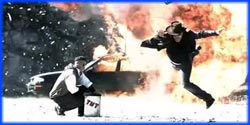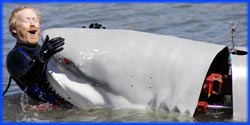


Premier Date: November 17, 2010
busted
Adam and Jamie first placed a small-scale car model in a water chamber to visualize the airflow around it. Whether it faced forward or reverse, they saw a large area of turbulence above the trailing end. Next, they measured the amount of drag force on the model when placed in a wind tunnel to gauge its aerodynamic character. The results were 0.34 pounds of drag forward and 0.37 pounds of drag in reverse.
In full-scale testing, Adam drove a typical 1970s sports car through three tests: a timed quarter-mile, time to accelerate from 0 to 60 mph (0 to 97 km/h), and fuel efficiency for a 1 mi (1.6 km) course at 50 mph (80 km/h). The car’s body was then removed, turned around, and reattached to the chassis, and Adam performed the same three tests. The forward car yielded averages of 14.0 seconds in the quarter-mile, 8.0 seconds in acceleration, and 0.87 lb (394.63 g) of fuel used. In reverse, the corresponding results were 16.6 seconds, 8.66 seconds, and 1.25 lb (566.99 g) of fuel. Finally, they brought the cars up to full speed – Adam in the reversed one, Jamie in an unmodified one – then put them into neutral and let them coast to the finish line. Jamie finished the race first, leading him and Adam to conclude that the cars were more aerodynamic as designed.
busted
The Build Team set up a full-scale test, towing a car with a board (“board car”) into a parked vehicle (“crash car”) set in front of a crash barricade to stop it dead on impact. A third vehicle (“target car”) was placed 40 ft (12.2 m) behind the crash car. Three attempts to replicate the movie crash failed, with the board pivoting sharply down and/or getting caught in the target car’s wreckage after flying off the roof.
Small-scale tests in the water chamber revealed that the board would not generate enough lift force to keep itself on a level path, leading the team to focus simply on the impact of the board against the windshield. Tory built a rig to launch it straight ahead, using bungee cords to provide the needed force; once it was properly calibrated, the team set a target vehicle directly in front and put Buster (outfitted with a human-analog neck) in the driver’s seat. The board only glanced off at 40 mph (64 km/h), while at 85 mph (137 km/h) it penetrated partway but was stopped by the safety glass in the windshield. Having failed to replicate either the movie crash or its results, the team declared the myth busted.
(This myth is based on a scene in the film Lethal Weapon 2.)
Previous: Episode 153: Mini Myth Madness